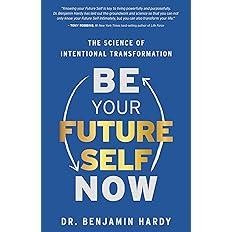Be Your Future Self Now: The Science of Intentional Transformation.
I've been down a rabbit hole with Dr Benjamin Hardy this last month and reference two of his other books in my thought piece. This is my favourite of his books and I use its framework often when working with coaching clients.
Be Your Future Self Now: The Science of Intentional Transformation.
by Benjamin Hardy (Author)
Amazon link : https://amzn.eu/d/4C2QYh7
Living With the Pull of the Future
In Be Your Future Self Now, Dr Benjamin Hardy unsettles our ordinary sense of time.
We are used to thinking of it as a straight line: the past behind us, the present where we stand, and the future waiting somewhere ahead. Hardy suggests that the future is not remote, but active. If imagined clearly enough, it can reach back and shape who we are today.
This is more than a clever thought experiment. Hardy’s claim is that our lives are constantly being directed by one of two selves: either the past self, with all its habits, assumptions and limitations, or the future self, with its clarity, purpose and possibility. Most of us, most of the time, live under the weight of the past. We replay old stories, act out familiar roles, and mistake continuity for inevitability.
But in this book he invites us to pause and reflect. Look back ten years: are you truly the same person you were then? Almost certainly not. Your priorities, your habits, your way of seeing the world will have shifted in countless ways. If such change has already occurred, then it is not fanciful to imagine that your future self — ten years from now — will be equally distinct. The question becomes: can you picture that person in enough detail to allow them to guide you today?
Hardy offers a simple but demanding exercise. Write down who you were a decade ago. Then write about who you are now. Notice the distance between the two. Next, project forward: who do you want to be in ten years’ time? Not in vague terms, but specifically — how you spend your days, what you value, what you’ve created or contributed. By vividly sketching this figure, you give your present self a reference point. Decisions that once felt muddled are reframed: does this choice bring me closer to my future self, or does it keep me bound to the past?
This reframing also extends backwards. Hardy suggests we can use the idea of non-linear time not only to draw on the future but to reinterpret the past. By changing the story we tell about what has already happened , by seeing past experiences as resources or lessons, rather than as limits, we can loosen the grip of old identities. In this sense, the future reshapes the past as well as the present.
The invitation in this book is both inspiring and uncomfortable. It asks us to admit that we are not fixed creatures but works in progress. It also removes the comfort of delay: if the future can shape us now, then waiting for the “right time” is simply avoidance. The work is to begin acting today in ways that are consistent with the person we intend to become.



